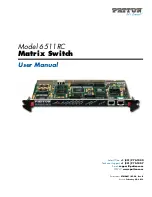
DES-3326SR Layer 3 Fast Ethernet Switch User’s Guide
40
Trap recipients are special users of the network who are given
certain rights and access in overseeing the maintenance of the
network. Trap recipients will receive traps sent from the
Switch; they must immediately take certain actions to avoid
future failure or breakdown of the network.
You can also specify which network managers may receive
traps from the Switch by entering a list of the IP addresses of
authorized network managers. Up to four trap recipient IP
addresses, and four corresponding SNMP community strings
can be entered.
SNMP community strings function like passwords in that the
community string entered for a given IP address must be used
in the management station software, or a trap will be sent.
The following are trap types the switch can send to a trap
recipient:
•
Cold Start This trap signifies that the Switch has been powered up and
initialized such that software settings are reconfigured and hardware
systems are rebooted. A cold start is different from a factory reset in
that configuration settings saved to non-volatile RAM used to reconfigure
the switch.
•
Warm Start This trap signifies that the Switch has been rebooted,
however the POST (Power On Self-Test) is skipped.
•
Authentication Failure This trap signifies that someone has tried to
logon to the switch using an invalid SNMP community string. The switch
automatically stores the source IP address of the unauthorized user.
•
Topology Change A Topology Change trap is sent by the Switch when any
of its configured ports transitions from the Learning state to the
Forwarding state, or from the Forwarding state to the Blocking state.
The trap is not sent if a new root trap is sent for the same transition.
•
Link Change Event This trap is sent whenever the link of a port changes
from link up to link down or from link down to link up.
•
Port Partition This trap is sent whenever the port state enters the
partition mode (or automatic partitioning, port disable) when more than
thirty-two collisions occur while transmitting at 10Mbps or more than
sixty-four collisions occur while transmitting at 100Mbps.
Summary of Contents for DES-3326SR
Page 12: ......
Page 173: ...DES 3326SR Layer 3 Fast Ethernet Switch User s Guide 161 Figure 6 11 Basic Switch Setup ...
Page 215: ...DES 3326SR Layer 3 Fast Ethernet Switch User s Guide 203 ...
Page 327: ...DES 3326SR Layer 3 Fast Ethernet Switch User s Guide 315 Figure 6 128 ARP Table ...
Page 343: ...DES 3326SR Layer 3 Fast Ethernet Switch User s Guide 331 Figure 6 142 Switch History ...
Page 349: ...DES 3326SR Layer 3 Fast Ethernet Switch User s Guide 337 INDEX ...
Page 352: ...340 W web based management 140 Weight 331 ...
Page 353: ......
Page 359: ......
















































